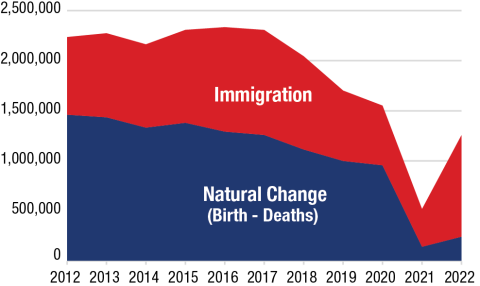Key Findings



The U.S. population grew by just 1,256,000 between July of 2021 and July of 2022, according to recent Census Bureau estimates. This was an increase from the record low growth of the preceding year, but it remains well below historical rates. There were just 245,000 more births than deaths in the past year, an increase from the 144,000 in the previous year, but still the second smallest natural gain in 80 years and a 76 percent decline from three years ago (Figure 1). Deaths reached a record high of 3,443,000 last year, 20 percent more than three years ago. In contrast, there were 3,688,000 births, a 2.9 percent increase over the preceding year, but still the second fewest since 1984. Because the natural gain was so small, immigration from abroad, which increased last year, accounted for 80 percent of the population gain.
COVID played a central role in this second year of modest population gain. In addition to 405,000 deaths directly attributable to COVID during the period, it also increased mortality by hindering people’s access to treatment for other health conditions and increasing deaths of despair.1 COVID also is discouraging people from having children in such difficult times.
The demographic forces that diminished U.S. population growth also influenced individual state population changes, though there is an important difference. While the nation’s migration gain comes entirely from net immigration from other countries, state migration gains or losses also include domestic migration—people moving between states. Therefore, state population change depends on the balance between births and deaths, and the net movement of people into and out of the state both from immigration and domestic migration. In all, 33 states including D.C. gained population last year, even fewer than the 35 that gained population in the previous year of the pandemic. Fewer births and more deaths played a key role in this slowdown. Deaths exceeded births in 24 states—more than in any year except the preceding one when 26 states had more deaths than births. The widespread incidence of states having more deaths than births is unprecedented in U.S. history. Between 2010 and 2018, an average of just 2 states had more deaths than births annually, though 5 states experienced it in 2019.
Among the 33 states that did gain population, 14 had both more births than deaths and a net inflow of migrants, and in 3 other states natural increase was sufficient to offset a migration loss (Figure 2). The population grew in 16 other states only because they gained enough migrants to offset a natural loss due to more deaths than births. Among the 18 states that lost population, 4 had both more deaths than births and a migration loss, and in 4 states the excess of death over births was greater than the migration gain. In the 10 remaining population-loss states there were more births than deaths, but not enough to offset a migration loss.

Source: U.S. Census Bureau Estimates. Analysis: K.M. Johnson, University of New Hampshire.

Source: U.S. Census Population Estimates. Analysis: K.M. Johnson, Carsey School, University of New Hampshire.
Looking ahead, the size of future population gains remains in doubt. Over the past decade, the number of deaths has been growing, while the number of births has diminished. As a result, the excess of births over deaths was already dwindling before the onset of the pandemic. COVID exacerbated these trends by significantly increasing mortality. As the impact of COVID on mortality wanes there are likely to be fewer deaths than in the past two years. Thus, the excess of births over deaths is likely to increase in the near term. How large this gain will be also depends on the number of births. Birth rates during the pandemic remained near historical lows, continuing a trend that began with the onset of the Great Recession 15 years ago. Currently, there is no evidence of any significant increase in fertility in response to births delayed by COVID. Even with continued low fertility, the diminished number of COVID deaths will produce an upturn in natural gain in the near term. Traditionally, the surplus of births over deaths has provided the bulk of the U.S. population gain. However, over the long term, mortality is likely to increase as the U.S. population continues to age, though certainly not at the rates evident during the pandemic. As it remains unclear whether fertility rates will increase in the future, immigration is likely to play an important role in the magnitude of future U.S. population gains.
1. A.M. White, I.P. Castle, P.A. Powell, R.W. Hingson, and G.F. Koob, “Alcohol-Related Deaths During the COVID-19 Pandemic,” JAMA, 327(17) (2022): 1704–1706. doi:10.1001/jama.2022.4308
This analysis is based on data from the Census Bureau Population Estimates Program released on December 22, 2022, covering July 1, 2021 to June 30, 2022. The Census Bureau estimation algorithms use 2020 Census data, provisional birth and death data from the National Center for Health Statistics, and additional administrative data to estimate current demographic trends. Census Bureau estimates of natural change (births - deaths), population, and migration are made using independent models, so they do not always sum to the total estimated population change. The difference is reported as a residual in Census Bureau databases, but not included here. Readers should recognize that although this analysis uses the best data available and is likely to be indicative of current trends, the data remain estimates. Concerns about both the quality of the 2020 Census and the impact of the Census Bureau’s Differential Privacy algorithms on the accuracy of the 2020 Census remain unresolved.

Kenneth M. Johnson is senior demographer at the Carsey School of Public Policy, professor of sociology at the University of New Hampshire, and an Andrew Carnegie Fellow. This research is supported by the NH Agricultural Experiment Station through joint funding from the USDA National Institute of Food and Agriculture (under Hatch-Multistate project W-5001, award number 7003437) and the state of New Hampshire. The opinions are his and not those of the sponsoring organizations. The research assistance of Tyrus Parker and GIS work of Barb Cook are gratefully acknowledged.
